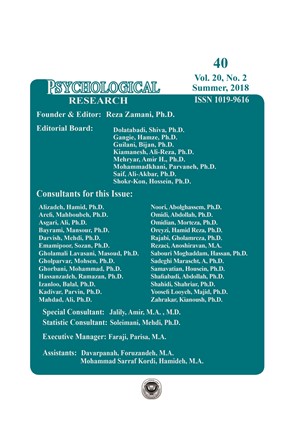Prediction of Schizophrenia Neuropsychological Characteristics Based on Social Cognition Aspects in a Non-Clinical Sample
Subject Areas :
1 -
Keywords: schizophrenia characteristic theory of mind alexithymia social cognition,
Abstract :
Abstract: The aim of the present study was to investigate the mutual relationship between characteristics of schizophrenia (Sc) with theory of mind and alexithymia, as social cognitive as-pects, in a nonclinical group. The research method was descriptive-correlational design of regression prediction. To do so, 200 university students (100 males, 100 females) were selec-ted by multistage cluster sampling from the two universities of Bonab city, East Azarbayjan province in Iran (Payame Noor and University of Bonab). Having any physical or psycho-neurological chronic illnesses was the elimi-nation criterion in the study. To collect data the 78-item scale of MMPI-2 for schizophrenia, Reading Mind from Eyes Test (RMET), and Alexithymia Questionnaire (FTAS-20) were used. Data were analyzed by Pearson's cor-relation test, linear regression analysis, and mul-tiple simultaneus regression analysis. According to the results, the predictive role of theory of mind and alexithymia in characteristics of schi-zophrenia were confirmed. Separately, theory of mind explained 19% and alexithymia explained 57% of the variance of neuro-psychological characteristics of schizophrenia. Studying the combined contribution of theory of mind and alexithymia in schizophrenic characteristics in-dicated that, among the two variables, only the predictive variable affecting features of schizo-phrenia was alexithymia (with beta=0.58).
بشارت، محمدعلی ) .(1388ناگویی هیجانی و مشکلات بین شخصی. پژوهشهاي روانشناسی بالینی و مشاوره، ).78-91 ،10(1
جوانمرد، غلامحسین ) .(1394آسیبشناسی روانی .2تهران: دانشگاه پیامنور.
کرمی، جهانگیر؛ زکییی، علی؛ و محبی، زینب ) .(1391رابطه آلکسیتیمیا و باورهاي مربوط به هیجان با سلامت روان بیماران کلیوي. ن روا شناسی سلامت ، ).19-29 ،4(1
گراثمارنات، گري ) .(1387راهنماي سـنجش روانـی. )ترجمـه حـسن پاشـاشـریفی، محمدرضـا نیکخـو(، تهران: رشد. )تاریخ انتشار اثر به زبان اصلی، .(2003 نجاتی، وحید؛ ذبیحزاده، عباس؛ ملکی، قیصـر؛ و محسـنی، مصـطفی ) .(1391اخـتلال شـناخت اجتماعی در بیماران دچار افسردگی عمده: شواهدي از آزمون ذهن خوانی از طریـق چشـم. فصلنامه روانشناسی کاربردي، سال ،6شماره .57-70 ،(24)4 نجاتی، وحید؛ ذبیحزاده، عباس؛ نیکفرجام، محمدرضا؛ نادري، زهره؛ و پورنقدعلی، علی. ) .(1391رابطه بین ذهنآگاهی و ذهنخوانی از روي تصویر چشم. مجله تحقیقات علوم پزشکی زاهدان، ).37-42،14(1 Adolphs, R. (2002). Neural systems for recognizing emotion. Current Opi nions Neurobiology, 12(2), 169-177. Baron-Cohen, S., Leslie, A. M. & Frith, U. (1985). Does the autistic child have a theory of mind? Cognition, 21, 37-46. Beer, J., & Ochsner, K. (2006). Social cognition: A multi-level analysis. Brain Research, 1079(1), 98-105. Bermond, B., Vorst, H., & Moormann, P. P. (2006). Cognitive neuro psychology of alexithymia: implications for personality typology. Cog nitive Neuropsychiatry, 11, 332-360. Blair, R. (2008). The amygdala and ventromedial prefrontal cortex: functional contributions and dysfunction in psychopathy. Philosophical Transactions of the Royal Society of London. Series B, Biological Sciences, 363(1503), 2557-2565.Bjorkquist, O. A., & Herbener, E. S. (2013). Social perception in schizophre nia: Evidence of temporo-occipital and prefrontal dysfunction. Psy chiatry Research, 212(3), 175-182. Burdick, K. E., Goldberg, J. F., Harrow, M., Faull, R. N., & Malhotra, A. K. (2006). Neurocognition as a stable endophenotype in bipolar disorder and schizophrenia. The Journal of Nervous and Mental Disease, 194(4), 255-260. Butcher, J. N., Julia, N., & Perry, J. N. (2008). Personality assessment in treatment planning: Use of the MMPI-2 and BTPI. Oxford University Press. Butcher, J. N., & Williams, C. L. (2009). Personality assessment with the MMPI-2: Historical roots, international adaptations, and current challenges. Applied Psychology: Health and Well-Being, 1(1), 105-135. doi:10.1111/j. 1758-0854.2008.01007 Dimoka, A., Pavlou, P. A., & Davis, F. D. (2007). Neuro-IS: The potential of cognitive neuroscience for information systems research. Information Systems Research, 22(4), 687-702 Everett, J., Lavoie, K., Gagnon, J., & Gosselin N., (2001). Performance of Patients with Schizophrenia on the WCST. Journal of Psychiatry & Neuroscience, 26(2), 123-130. Gavilan, J. M., & Garcia-Albea, J. E. (2011). Theory of mind and language comprehension in schizophrenia: Poor mindreading affects figurative language comprehension beyond intelligence deficits. Journal of Neuro linguistics, 24, 54-69. Goff, D. C., Hill, M., & Barch, D. (2011). The treatment of cognitive impairment in schizophrenia. Pharmacology, Biochemistry and Behavior, 99(2), 245-253. Green, M. F., Penn, D. L., Bentall. R., Carpenter, W. T., Gaebel, W., & Gur, R. C. (2008). Social cognition in schizophrenia: an NIMH Workshop on define tions, assessment, and research opportunities. Schizophrenia Bulletin, 34(6), 1211-1220. Halgin, R. P., Whitbourne, S. K. (2010). Abnormal psychology, clinical pers pectives on psychological disorders (6thed.). New York: McGraw-Hill. Herrmann, M. J., Ellgring, H., & Fallgatter, A. J. (2004). Early-stage face processing dysfunction in patients with schizophrenia. American Journal of Psychiatry, 161(5), 915-917. Honkalampi, K., Hintikka, J., Saarinen, P., Lehtonen, J., & Viinamaki, H. (2000). Is alexithymia a permanent feature in depressed outpatients?


